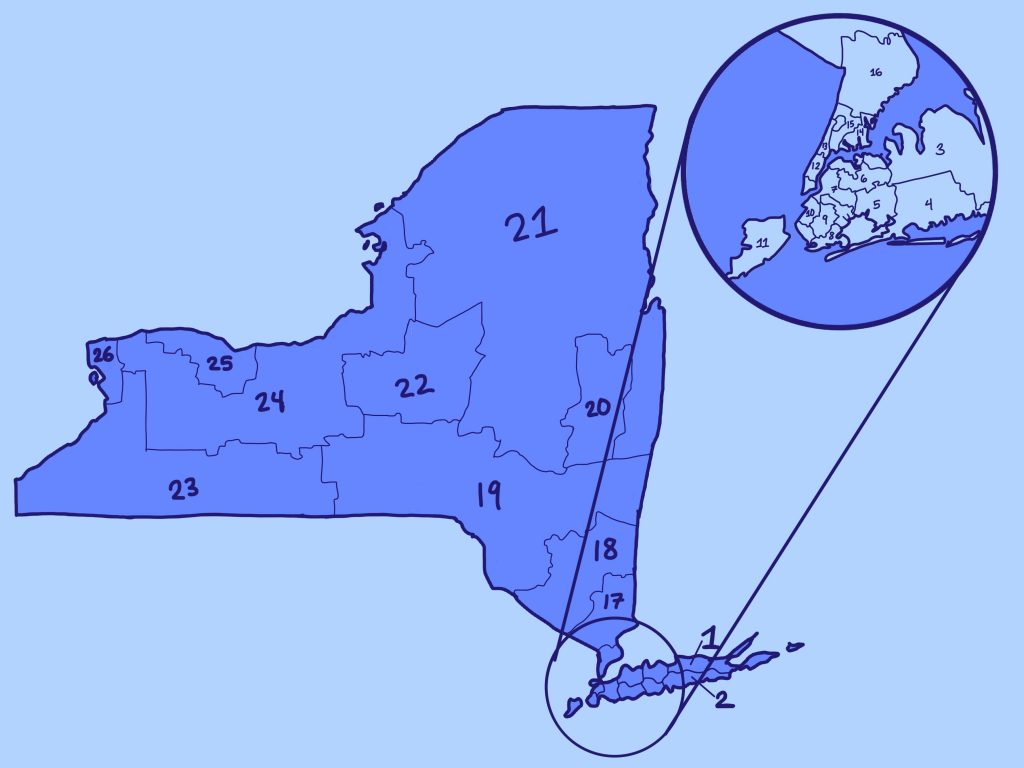Over the past three years, the New York State Legislature and an Independent Redistricting Commission (IRC) have been at odds over drawing congressional districts. This November, the New York State Court of Appeals will hear arguments in a case that will determine if the current maps should be redrawn or remain for the entire decade.
Every 10 years, each state draws new congressional districts utilizing newly released census data. Traditionally, state legislatures are responsible for redrawing the lines to ensure that each congressional district has a roughly equal population. In 2014, New York state voters established the IRC, a 10-member body equally chosen by majority and minority leaders in the State Senate, the State Assembly and the remaining appointees, responsible for drawing new congressional districts going forward. While many hoped that the IRC would eliminate partisan fights over redistricting, the commission deadlocked in January 2022, failing to come to a consensus.
Redistricting then returned to the State Legislature, where the Democratic supermajority in both chambers proposed new congressional maps that were projected to award Republicans four of 26 districts. The map was criticized by legal and political experts as being overtly partisan. In a statement to the New York Times, Michael Li, senior counsel for the Democracy Program at the Brennan Center for Justice and a previous critic of Republican-led gerrymanders, said that the proposed map was obviously unfair.
“It’s a master class in how to draw an effective gerrymander,” Li said. “Sometimes you do need fancy metrics to tell, but a map that gives Democrats 85 percent of the seats in a state that is not 85 percent Democratic — this is not a particularly hard case.”
In a statement on X, formerly Twitter, Rep. Marc Molinaro, whose district includes the Southern Tier, criticized the redistricting saga. He narrowly won election in 2022 against Josh Riley, a Democrat running again in 2024.
“Dragging redistricting on for years is a disservice to voters,” Molinaro wrote. “Voters deserve clarity and fairness.”
Democratic leaders in the Legislature defended their map as compliant with redistricting criteria. State Sen. Michael Gianaris, the chamber’s deputy majority leader, said that the maps were drawn fairly and consistent with political reality.
The proposed maps were passed by both chambers and signed into law by Gov. Kathy Hochul in February 2022. After, a group of GOP-backed voters filed a lawsuit in Steuben County, claiming that the maps violated the state constitution. A county judge voided the maps and ordered that the legislature redraw them before April 11, 2022. The Court of Appeals then ruled that the congressional maps violated redistricting procedure and directed the judge to appoint a neutral expert to create entirely new districts.
The resulting court-drawn maps were implemented for the 2022 midterm elections, leading to Republicans flipping three congressional seats, which contributed to their narrow retaking of the House of Representatives.
Democrats have since sued, arguing that the court-drawn maps were intended to be a temporary measure and that the redistricting process should restart to produce new district boundaries for the 2024 election cycle. In July, a state appellate court agreed, ordering the IRC to begin the redrawing process. In response, Republicans then appealed to the Court of Appeals, which will meet in Buffalo on Nov. 15 to hear arguments in the case.
Rachel Pasternack, a sophomore majoring in history, said that the GOP-backed voters had the right to file suit, referencing Minnesota, who avoided losing a district to New York state by 89 votes.
“The loss of a congressional seat in 2022 was extremely close and was likely due to the district being the most Republican, which is why Republicans want to win it back and they do have the right to sue,” Pasternack wrote. “I understand though why the seat was lost, and I think it’s more important that Minnesota gained it as it is — while mainly Democratic — much more politically divided compared to New York [state]. If Minnesota did not gain the seat, results could have potentially been different. New York [state], however, would’ve likely been the same.”



